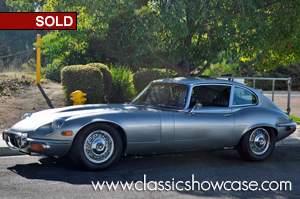1971 Jaguar-XKE Series 3 V12 2+2
Specifications |
|
| Stock: | J71-991 |
| Current condition: | DRIVER |
| Performance: | V12 5343 cc | 326.1 cu in. | 5.3 L., Zenith-Stromberg 175 CD2SE SOHC |
| Transmission: | Automatic |
| Suspension: | Independent Front / Rear |
| Color exterior: | Silver |
| Color interior: | Black |
| Features: | Factory Air Conditioning; AM/FM Stereo System |
| Mileage: | 71,883 showing |
| Wheels: | Steel wheels with hubcaps |
| Tires: | Michelin Defender 215/70/15 |
| Vin #: | 1S70991BW |
| Engine #: | 7S14638LB |
| Gearbox #: | 10602 |
| Other 1: | Body Number: 4S51151 |

Description
(SOLD)
History
The E-Type Series 3 was introduced in 1971, with a new 5.3 L twelve-cylinder Jaguar V12 engine, uprated brakes and standard power steering. The short wheelbase FHC body style was discontinued and the V12 was available only as a convertible and 2+2 coupé. The convertible used the longer-wheelbase 2+2 floorplan. The Series 3 is easily identifiable by the large cross-slatted front grille and flared wheel arches, and a badge on the rear that proclaims it to be a V12. Cars for the US market were fitted with large projecting rubber bumper over-riders (in 1973 these were on front, in 1974 both front and rear to meet local 5 mph (8 km/h) impact regulations, but those on European models were considerably smaller. US models also have side indicator repeats on the front wings. There were also a very limited number of six-cylinder Series 3 E-Types built. These were featured in the initial sales literature. When leaving the factory the V12 Open Two Seater and V12 2 ± 2 originally fitted Dunlop E70VR − 15 inch tires on 15 × 6K wire or solid wheels.
